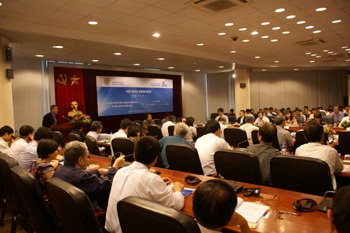The Research Centre for Imperial Citadel (Vietnam Academy of Social Sciences – VASS) held the international seminar on “Evaluating the research findings after six years on the A and B areas at the relic site of Thang Long Royal Palace” on 13-14 September 2013 in Hanoi.
The seminar received the presence of Japanese experts, historians, and archeologists from Meiji University, Nara Women’s University, Research Institute of National Cultural Heritage. Vietnamese delegates at the seminar were the experts and scholars from the research institutes of VASS, the Vietnam Association of History, Hanoi National University, and the representatives from the Ministry of Culture, Sports and Tourism and the museums in Hanoi.
Opening the seminar, Prof.Dr. Nguyen Xuan Thang, Member of the Party Central Committee, President of VASS, said the aim of the seminar was to discuss and evaluate the research findings and the values of different types of architecture on the A and B areas. The research was carried out by the Institute of Archaeology and the Research Centre of Imperial Citadel since 2008 concerning the planning, construction techniques, nature, chronology, functions, and architectural morphology.
The excellence and uniqueness of the areas A and B were that many cultural layers of different periods of time overlapped and interwove in succession. They comprised the architectural monuments from the times of Dai La, Dinh and Pre-Le dynasties, and the dynasties of Ly, Tran, Le as well as the vestiges of rivers, ponds, and lakes. The ruins were interconnected and associated with each other, forming a continuous whole complex of diversity and attractiveness. This reflected the relations between urban planning and architectural space, as well as a continuation between the dynasties in the history of Thang Long capital construction. Besides, millions of artifacts found here, many of which were ceramics from China, Japan, and the West Asia, were the demonstration for the relationships and the economic and cultural exchanges in the history of Thang Long.
 |
According to Dr. Bui Minh Tri, Director of the Research Centre for Imperial Citadel, the research results in the past six years had made strides in terms of cognition and evaluation. Many questions of hypothesis or speculation or unanswered in the earlier stage of the study were basically clarified up to date. Although the architectural splendor of Thang Long Royal Palace was no longer intact, the archaeological discoveries underground in these areas were the convincing evidences for the meticulous construction of magnificent palaces and buildings inside the Imperial Citadel of Thang Long. A large number of different types of artifacts, such as circular objects, reliefs and tiles with decorative dragons and phoenix showed that Thang Long Royal Citadel architecture was designed for a brilliant display of splendid beauty with the ornaments of kingship, presenting the majestic and imposing emperorship. This medium served both as the administrative center and the forbidden city of the Ly, Tran and Le dynasties in the succession of ruling the country.
Prof. Kazuto Inoue (Meiji University, Japan) in his paper stated the important role of archaeological equipments for the investigation of constructional measurements and the direction of the palaces under the Ly Dynasty. The analysis of the Ly palaces from the perspective of the measurements and construction planning had proven practically the qualification of design and construction techniques once applied here.
Doing research on the roof tiles in Dai La period, Dr. Koki Imai (Nara Research Institute of National Cultural Heritage, Japan) believed that it was not yet possible to draw firm conclusions about whether or not the same way of using different types of tiles was adopted in Thang Long. An overall survey was required for all types of tiles unearthed before coming to a comprehensive assertion. Many similar types of tiles were found in the Liao and Northern Song periods and they seemed to be created later than the Dai La (the 7th-9th centuries).
The value of the relics was recognized more generally and fully in terms of appearance, scale, nature, functions and dates in each. The skills, constructional techniques, urban planning, and uniqueness of the architecture in the royal palace of Thang Long over the periods were better evaluated. They were still, however, the major issues that required clearer proofs.
The international seminar was for the academic exchanges between the domestic and international scholars. It carried the importance for the fact that the scholars, once again, would recognize the research findings of architectural relics and would provide a more objective and academic assessment, so that to further the confirmation about what had been done and what had not and also to pose the problems for further research.
Nguyen Thu Ha







